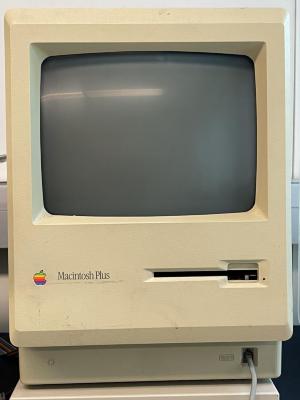Apple's March to the Future ➔ Macintosh Plus
physical object
Identifier
2023.3.1Description
Although the Macintosh was a successful and revolutionary device, it still had its fair share of limitations. Some of which include limited memory and lack of a hard disk drive or the means to easily connect one. On September 10, 1984, Apple would release the second model of the Macintosh, the Macintosh 512K, and increase the memory capacity of the Mac to 512 Kb but they found that it was difficult and inconvenient to increase the memory capacity from 128 Kb to 512 Kb when using the original model. To fix some of these flaws, Apple decided to release the Macintosh Plus on January 10, 1986, which not only was an immediate success, but it also proved its longevity by being the longest lasting Macintosh product in production, lasting until October 15, 1990 (4 years and 10 months). The Macintosh Plus came standard with 1 megabyte of RAM, and a maximum capacity of 4 megabytes, and a revolutionary SCSI parallel interface which could connect seven peripheral devices to the computer simultaneously. In addition, the Macintosh Plus was the first Apple device released after Job’s resignation on September 16, 1985, due to a power struggle of control over the company with John Sculley.The Mac Plus was the first Macintosh model to include a SCSI port, which started the popularity of external SCSI devices for Macs, including hard disks, tape drives, CD-ROM drives, printers, and even monitors. SCSI ports remained standard equipment for all Macs until the introduction of the iMac in 1998. The Macintosh Plus was the last classic model to have a port resembling that of a phone cord in front of the keyboard, as well as the DE-9 connector for the mouse since later models would use ADB ports. It had a new 3.5-inch double-sided 800 KB floppy drive, offering double the capacity of previous Macs along with backward compatibility. The 800 KB drive had two read/write heads, enabling it to simultaneously use both sides of the floppy disk and thereby doubling the storage capacity.
The Mac Plus was the first of several Macintoshes to use SIMMs (single in-line memory modules) for its memory. It had 128 KB of ROM on the motherboard, which was double the amount of ROM that was in previous Macs; the new System software and ROMs included routines to support SCSI and the new 800 Kb floppy drive. In addition to the typical MacWrite and MacPaint that came along with the Macintosh, the Macintosh Plus included the convenient HyperCard and MultiFinder which allowed users to multitask and use multiple applications simultaneously. Like the previous Mac models, the Plus still did not provide adequate support for an internal hard drive, and it would take over 9 months before Apple would offer a SCSI drive replacement for the slow Hard Disk 20. It would take well over a year before Apple would offer the first internal hard disk drive in any Macintosh. The Plus had a 9-inch, 512 x 342 pixel monochrome display with a resolution of 72 PPI, identical to that of previous Macintosh models. Unlike earlier Macs, the Mac Plus's keyboard included a numeric keypad and directional arrow keys, and, as with previous Macs, it had a one-button mouse and no fan, making it extremely quiet during performance.
